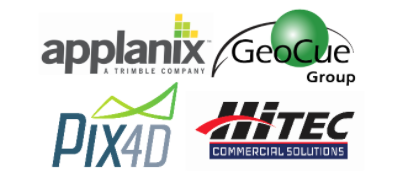With the ability to perform land surveys, photogrammetry, 3D mapping, topographic surveying, and more, drones have become one of the primary tools for GIS professionals to do their jobs. Last month, Commercial UAV News held a 5 Things You Need to Know About Surveying with a Drone webinar with a group of surveying experts to learn what they think about surveying with drones from choosing the right hardware, provider, and software for the job to delivering a high-quality product.
1. Selecting the Right Equipment
When selecting equipment for an operation, the first consideration is always to understand what you or a customer is looking for. Jim Bonnardel, Drone Service Specialist at Hitec Commercial Solutions, recommends taking time to study the available deliverables to determine which will meet the requirements for a specific operation.
“As a Pix4D customer, the incredible array of deliverables and output products from our sensors and our aircraft to the customer is one of the things that helps us tremendously,” Bonnardel added. “Those are the things that a new customer doesn’t often have a full education base on, so educating them helps us determine which sensors are best for their need.”
Lewis Graham, President CTO at GeoCue Group, reinforced the need to understand what’s needed for an operation before thinking about equipment. Besides that, he talked about the main sensor types used for surveying, such as multispectral, and lidar with photogrammetry, and how to choose the right one. “Once you know what the customer’s products are by figuring out in a conversation with the customer what the desired accuracy is. Look to the customer and derive it from there.”
Finally, Brad Schmidt, Global Sales Manager at Applanix Corporation, went through the various methodologies for drones in surveying, including Ground Control Points (GCP), PPK, RTK, and Direct Georeferencing. “Take a look at the methodology you want or choose to use, and then select a technique you want to implement. Match up the technology with the application that you’re planning on working with.”
2. Automation and Machine Learning in Surveying
While drones can efficiently speed up surveying operations, it’s not all about the hardware itself, but also the software behind it to process and analyze the collected data. One of the most important goals of Artificial Intelligence in the drone industry is to automate the analysis of large data sets collected by drones and make it more efficient while removing a human from the loop.
Companies, such as Pix4D, are constantly working on new and improved ways to increase the automation within the workflow so it becomes easier for the surveyor on the field. For example, Pix4D recently released a new feature to automatically detect GCPs with machine learning.
“Increasing the automation by using pattern recognition, by developing algorithms that can make that easier on the end client, is the focus today.” Angad Singh, Business Development Executive at Pix4D, said.
Another focus of Pix4D is increasing the capability of cleaning point clouds. Singh added that Pix4D is putting efforts into using “some sort of machine learning or statistical capability to ensure the point cloud gets better and the same image set someone collected three years ago, if it’s run through a software package like Pix4DMapper, today, the point cloud will come up cleaner.”
3. Scaling Surveying Operations
Succeeding with and scaling a drone program can be quite challenging not only in surveying but also in other drone verticals. During the webinar, Bonnardel talked about forced and planned scaling, growth, staffing, clients, and marketing and sales, which he considers major bullet points to scaling.
“Marketing and sales are where you can truly make a difference. Serving the client is what we need to do, but we can’t grow if we’re working the client’s jobs. We need to be able to grow and provide those services at the same time,” Bonnardel added.
Additionally, Schmidt went into detail on how gaining efficiencies like reducing data overlap, not using GCPs, improving processing time, and using augmentation systems is one way that georeferencing can contribute to scaling a business.
4. Validating Surveying Data
To ensure data integrity and efficiency during the data collection process and processing, Graham and Schmidt mentioned there are many factors to take into consideration, such as connecting with and understanding customers, actively verifying and validating data, or choosing PPK vs RTK.
“We’ve done around 4000 metric mapping projects since we started in the drone business, and it took us a while to learn the most important thing to do is to connect with the customer,” Graham said. “No matter how much attention you pay internally to accuracy, if you’ve got 10 centimeters of noise and your customer expects 5, then you’re not going to meet their expectations.”
Another misconception Graham regularly sees is a focus on batteries. “Quit thinking about batteries, think about data. Your objective is not to minimize how many flights you do, it is to maximize the quality of the data you get. When you get back to the office, you can always thin data, but no one has come up with an algorithm to make it thicker.”
5. Visualizing Data for Deliverables
Whether it’s lidar, RTK/PPK, elevation reports, or just photogrammetry, Bonnardel claims it’s important to have different examples of the deliverables to present to clients.
“I often find different examples of the same data set are what helps clients understand and visualize those differences,” he explained. “Listen to those clients that are the experts in the field as they can often help with something that you’re not on.”
These are only some of the parts discussed during the webinar, so make sure to watch it on demand to learn more.
You can access it here.















Comments